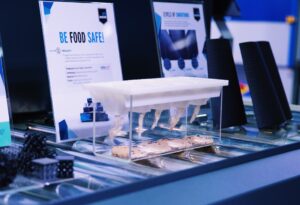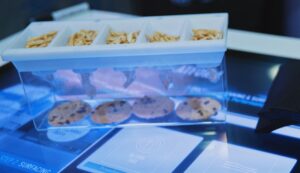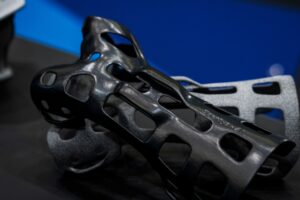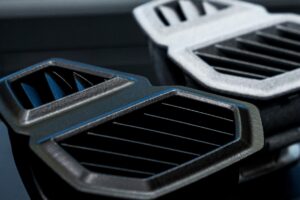
Mass production with simultaneous individualization has long been considered one of the big goals and one of the greatest differentiators of 3D printing to all previous, traditional manufacturing methods. In the development of a fully functional mass customization process chain, post-processing plays a crucial role. Post-processing companies like DyeMansion, headquartered in Munich, Germany, have taken elementary steps in the past to grow the final link in the 3D-printing process chain into a state-of-the-art technology with the necessary quality factor. Like Pat Carey, Vice President of Stratasys, brings it to the point: “This enables our customers to easily move from powder to consistent, quality finished parts at scale.”
State-of-the-art is a broad term, so let’s take a closer look at some key factors and example applications in the mass production area, which play a main role, especially in post-processing using the example of DyeMansion. A concept that has recently become increasingly important in this context is the “Factory of the Future”. This expression defines a vision of how manufacturers can take their production to a new level by improving three major dimensions: plant digitalization, plant processes and plant structure. Under the motto “Future up your Factory”, DyeMansion, presented its solutions for these dimensions at Formnext 2023 trade show and demonstrated that post-processing is ready for the demands of the future.
DyeMansion 360 Digital Services, is the name of the software application that responds to the plant digitalization pillar. It serves as a central point for all digital services with DyeMansion products. Digital access points like this one, which can be seamlessly integrated into each customer’s digital environment, are adapted to a world of tomorrow in which location-independent monitoring of machines and remote technical service support are becoming increasingly important building blocks in modern production chains. This saves valuable resources and enables much faster action in the event of production disruptions, which is a particularly important factor in serial production. A look into the near future shows that the data obtained from the user behavior of customers when operating the machines can be used in an unprecedented way to undertake process but also hardware adjustments that enable continuous and user-friendly improvement. Here we are already fully in the second Factory of the Future dimension: the “plant process”.
Identifying the need for improvement or demand is only the first step. The development of new technologies also outside the digital environment is another big part to keep post-processing and thus the whole 3D-printing industry on a state-of-the-art level. One example is the food & beverage industry, which has some of the largest production chains in the world and is therefore a big player in many manufacturing sectors with a strict regulatory authority, the FDA (US Food & Drug Administration) without whose licensing no materials may come into food contact. The development of a food-safe chemical smoothing process with an FDA-licensed quality recently opened the door for various manufacturers producing food contact applications. One application that was manufactured with the Powerfuse S chemical smoothing machine from DyeMansion directly after FDA licensing is the food dispenser from Kuhn-Stoff. It is used to dispense toppings such as chocolate flakes, almond chips and more onto cookies passing underneath. Due to the surface smoothing, the part does not absorb any liquids and is particularly easy to clean, a desirable benefit for many food and beverage applications.
- Figure 2: Food dispenser by Kuhn-Stoff can be put in food contact thanks to Powerfuse S smoothing technology
- Figure 2: Food dispenser by Kuhn-Stoff can be put in food contact thanks to Powerfuse S smoothing technology
Further milestones in the development of new technologies of the 3D printing future are not dependent on licensing but on technology barriers. One of the most used plastics in the world is Polypropylene (PP). Widely chosen for all sorts of everyday items, such as shampoo bottles, lids, storage cans and many more. Although 3D-printing of PP has been functional for some time, the demand for 3D-printed PP Parts has remained low. What was the reason for that? The post-processing of PP, especially a chemical smoothing process, which can compete with conventional injection molding technology, was not available. With the new development of the Powerfuse S PP Machine, specifically for the smoothing of PP parts, DyeMansion has enabled a new, promising market for the 3D-printing industry, whose path must now be developed together with all process members.
- Figure 3: Applications printed with Polypropylene (PP) – chemical smoothed by Powerfuse S PP
- Figure 3: Applications printed with Polypropylene (PP) – chemical smoothed by Powerfuse S PP
Improvements and further developments in postprocessing can thus sometimes give wings to the entire industry. Post-processing, as the last link in the 3D printing chain, is not only heavily dependent on developments within the printing sector, but also on the software side, in order to open up ever new fields of application, meet ever higher requirements and, above all, play a decisive role in our everyday lives in the near future through mass customization.
DyeMansion is participating in Additive Manufacturing Strategies, taking place in New York City from February 7-9, 2023. Mike Schorr, Director of Application Consulting for DyeMansion North America Inc., will be on the panel “Post Processing: State of the Art” on February 9. Register for your ticket to attend here.
Subscribe to Our Email Newsletter
Stay up-to-date on all the latest news from the 3D printing industry and receive information and offers from third party vendors.
You May Also Like
3D Printing Unpeeled: New Arkema Material for HP, Saddle and Macro MEMS
A new Arkema material for MJF is said to reduce costs per part by up to 25% and have an 85% reusability ratio. HP 3D HR PA 12 S has been...
3D Printing News Briefs, January 20, 2024: FDM, LPBF, Underwater 3D Printer, Racing, & More
We’re starting off with a process certification in today’s 3D Printing News Briefs, and then moving on to research about solute trapping, laser powder bed fusion, and then moving on...
3D Printing Webinar and Event Roundup: December 3, 2023
We’ve got plenty of events and webinars coming up for you this week! Quickparts is having a Manufacturing Roadshow, America Makes is holding a Member Town Hall, Stratafest makes two...
Formnext 2023 Day Three: Slam Dunk
I’m high—high on trade show. I’ve met numerous new faces and reconnected with old friends, creating an absolutely wonderful atmosphere. The excitement is palpable over several emerging developments. The high...




































